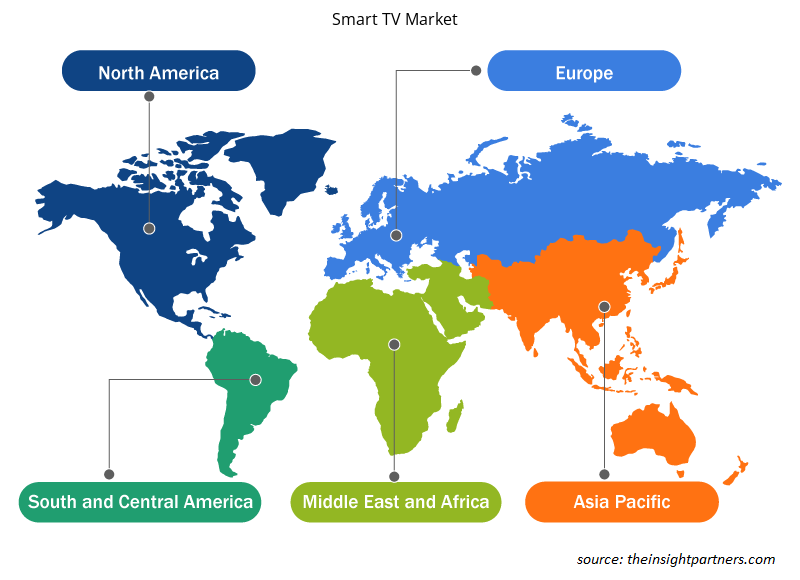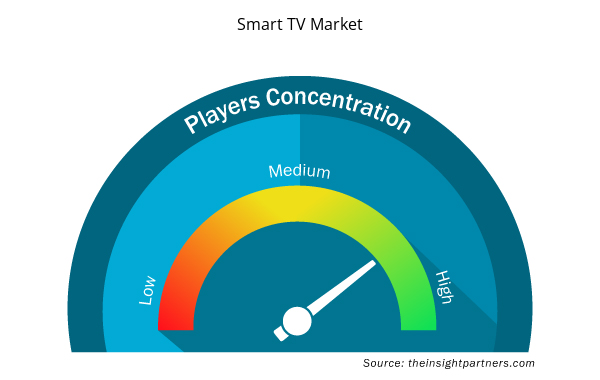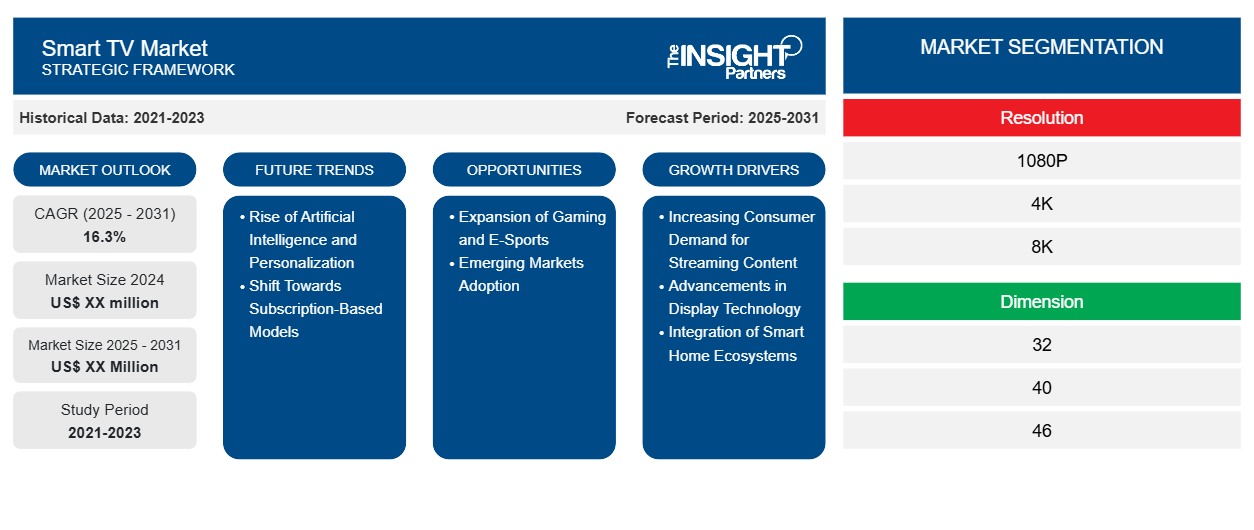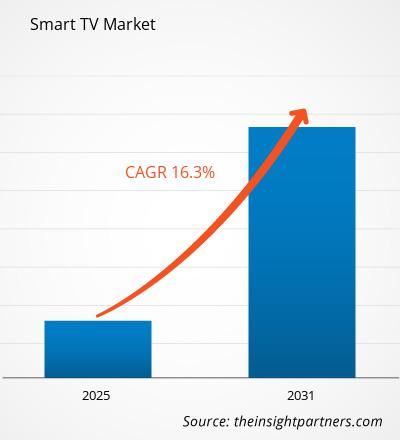Es wird erwartet, dass der Smart-TV-Markt von 2024 bis 2031 eine durchschnittliche jährliche Wachstumsrate (CAGR) von 16,3 % verzeichnet, wobei die Marktgröße von XX Millionen US-Dollar im Jahr 2024 auf XX Millionen US-Dollar im Jahr 2031 anwachsen wird.
Der Bericht ist segmentiert nach Auflösung (1080P, 4K, 8K, Sonstige), Dimension (32, 40, 46, 55, 75 und höher), Dynamikbereich (Standard, HDR), Anwendung (Wohnbereich, Gewerbe). Die globale Analyse ist weiter auf regionaler Ebene und in die wichtigsten Länder unterteilt. Der Bericht bietet den Wert in USD für die oben genannte Analyse und Segmente
Zweck des Berichts
Der Bericht Smart TV Market von The Insight Partners soll die aktuelle Situation und das zukünftige Wachstum sowie die wichtigsten treibenden Faktoren, Herausforderungen und Chancen beschreiben. Dies wird verschiedenen Geschäftspartnern Einblicke geben, wie zum Beispiel:
- Technologieanbieter/-hersteller: Um die sich entwickelnde Marktdynamik zu verstehen und die potenziellen Wachstumschancen zu kennen, damit sie fundierte strategische Entscheidungen treffen können.
- Investoren: Durchführung einer umfassenden Trendanalyse hinsichtlich der Marktwachstumsrate, der finanziellen Marktprognosen und der Chancen entlang der Wertschöpfungskette.
- Regulierungsbehörden: Zur Regulierung von Richtlinien und Überwachungsaktivitäten auf dem Markt mit dem Ziel, Missbrauch zu minimieren, das Vertrauen der Anleger zu bewahren und die Integrität und Stabilität des Marktes aufrechtzuerhalten.
Smart-TV-Marktsegmentierung
Auflösung
- 1080P
- 4K
- 8K
- Sonstiges
Dimension
- 32
- 40
- 46
- 55
- 75 und höher
Dynamikbereich
- Standard
- HDR
Anwendung
- Wohnen
- Kommerziell
Passen Sie diesen Bericht Ihren Anforderungen an
Sie erhalten kostenlos individuelle Anpassungen an jedem Bericht, einschließlich Teilen dieses Berichts oder einer Analyse auf Länderebene, eines Excel-Datenpakets sowie tolle Angebote und Rabatte für Start-ups und Universitäten.
- Holen Sie sich die wichtigsten Markttrends aus diesem Bericht.Dieses KOSTENLOSE Beispiel umfasst eine Datenanalyse von Markttrends bis hin zu Schätzungen und Prognosen.
Wachstumstreiber auf dem Smart-TV-Markt
- Steigende Verbrauchernachfrage nach Streaming-Inhalten: Die zunehmende Beliebtheit von Streaming-Diensten wie Netflix, Hulu und Amazon Prime Video ist ein wichtiger Treiber des Smart-TV-Marktes. Verbraucher suchen zunehmend nach Geräten, die einen nahtlosen Zugriff auf eine Vielzahl von Online-Inhalten wie Filme, Fernsehsendungen und Live-Sport bieten. Smart-TVs, die mit integrierten Apps und benutzerfreundlichen Schnittstellen ausgestattet sind, erfüllen diese Nachfrage, indem sie direkte Streaming-Funktionen bieten. Da immer mehr Haushalte von herkömmlichen Kabelabonnements abrücken, wächst der Wunsch nach Smart-TVs, die das Fernseherlebnis verbessern, weiter und steigert die Marktumsätze.
- Fortschritte in der Displaytechnologie: Kontinuierliche Fortschritte in der Displaytechnologie, wie 4K, OLED und QLED, treiben den Smart-TV-Markt voran. Diese Technologien verbessern die Bildqualität und bieten den Verbrauchern schärfere Bilder, lebendigere Farben und einen verbesserten Kontrast. Da die Hersteller innovativ sind und neue Funktionen einführen, werden die Verbraucher zunehmend von leistungsstarken Smart-TVs angezogen, die ein überragendes Seherlebnis bieten. Darüber hinaus unterstützt die wachsende Verfügbarkeit von hochauflösenden Inhalten die Einführung fortschrittlicher Displaytechnologien und treibt die Nachfrage nach Smart-TVs auf dem Markt weiter an.
- Integration von Smart-Home-Ökosystemen: Der wachsende Trend zur Smart-Home-Automatisierung beeinflusst den Smart-TV-Markt erheblich. Verbraucher suchen nach Geräten, die sich nahtlos in ihre vorhandenen Smart-Home-Systeme integrieren lassen, wie etwa Sprachassistenten (z. B. Amazon Alexa, Google Assistant) und Heimautomatisierungsprodukte. Smart-TVs, die mit verschiedenen Smart-Home-Geräten kompatibel sind, bieten zusätzlichen Komfort und verbessern das Benutzererlebnis. Mit der Entwicklung des Marktes wird die Möglichkeit, Smart-Home-Funktionen über Smart-TVs zu steuern, zu einem wesentlichen Merkmal, das das Interesse der Verbraucher steigert und das Marktwachstum steigert.
Zukünftige Trends auf dem Smart-TV-Markt
- Aufstieg künstlicher Intelligenz und Personalisierung: Die Integration künstlicher Intelligenz (KI) in Smart-TVs wird zu einem wichtigen Trend und verbessert das Benutzererlebnis durch personalisierte Inhaltsempfehlungen und intelligentere Schnittstellen. KI-Algorithmen analysieren Sehgewohnheiten und Vorlieben, um relevante Sendungen, Filme und Anwendungen vorzuschlagen, sodass Benutzer leichter neue Inhalte entdecken können. Da Smart-TVs intuitiver werden und auf individuelle Vorlieben reagieren, wird dieser Trend voraussichtlich die Erwartungen der Verbraucher prägen und weitere Innovationen auf dem Smart-TV-Markt vorantreiben.
- Umstellung auf abonnementbasierte Modelle: Es gibt einen wachsenden Trend zu abonnementbasierten Modellen für die Bereitstellung von Inhalten auf Smart-TVs. Viele Verbraucher bevorzugen die Flexibilität, verschiedene Streaming-Dienste zu abonnieren, anstatt sich an herkömmliche Kabelpakete zu binden. Dieser Wandel führt zur Entstehung gebündelter Abonnementdienste, bei denen Verbraucher über ein einziges Paket auf mehrere Plattformen zugreifen können. Da dieser Trend an Fahrt gewinnt, werden Smart-TV-Hersteller wahrscheinlich Partnerschaften mit Streaming-Diensten eingehen, um exklusive Pakete anzubieten, die den Gesamtwert für Verbraucher steigern und den Smart-TV-Umsatz steigern.
Marktchancen für Smart-TVs
- Expansion von Gaming und E-Sport: Die boomende Gaming-Branche bietet eine lukrative Chance für den Smart-TV-Markt. Mit dem Aufstieg von Online-Gaming und E-Sport suchen Verbraucher zunehmend nach Smart-TVs, die hohe Bildwiederholraten, geringe Latenzzeiten und immersive Grafiken bieten. Hersteller können diesen Trend nutzen, indem sie Smart-TVs entwickeln, die speziell für Gaming-Erlebnisse optimiert sind und über dedizierte Gaming-Modi und Kompatibilität mit beliebten Spielekonsolen verfügen. Indem sie die Gaming-Zielgruppe ansprechen, können Unternehmen ihre Marktreichweite erweitern und den Umsatz in diesem wachsenden Segment steigern.
- Einführung in Schwellenmärkten: Die Verbreitung von Smart-TVs in Schwellenmärkten stellt eine erhebliche Wachstumschance dar. Da das verfügbare Einkommen steigt und die Internetdurchdringung in Regionen wie dem asiatisch-pazifischen Raum, Afrika und Lateinamerika zunimmt, möchten immer mehr Verbraucher ihre Unterhaltungssysteme aufrüsten. Unternehmen können ihre Marketingstrategien und Produktangebote an die besonderen Bedürfnisse und Vorlieben dieser Märkte anpassen, beispielsweise durch die Bereitstellung erschwinglicher Smart-TV-Optionen mit lokalisierten Inhalten. Dieser strategische Fokus auf Schwellenmärkte kann zu erheblichem Umsatzwachstum führen und die Markenpräsenz weltweit stärken.
Regionale Einblicke in den Smart-TV-Markt
Die regionalen Trends und Faktoren, die den Smart-TV-Markt im Prognosezeitraum beeinflussen, wurden von den Analysten von Insight Partners ausführlich erläutert. In diesem Abschnitt werden auch die Marktsegmente und die geografische Lage des Smart-TV-Marktes in Nordamerika, Europa, im asiatisch-pazifischen Raum, im Nahen Osten und Afrika sowie in Süd- und Mittelamerika erörtert.

- Holen Sie sich regionale Daten zum Smart-TV-Markt
Umfang des Smart-TV-Marktberichts
| Berichtsattribut | Details |
|---|---|
| Marktgröße im Jahr 2024 | XX Millionen US-Dollar |
| Marktgröße bis 2031 | XX Millionen US-Dollar |
| Globale CAGR (2025 - 2031) | 16,3 % |
| Historische Daten | 2021-2023 |
| Prognosezeitraum | 2025–2031 |
| Abgedeckte Segmente | Nach Auflösung
|
| Abgedeckte Regionen und Länder | Nordamerika
|
| Marktführer und wichtige Unternehmensprofile |
|
Dichte der Smart-TV-Marktakteure: Die Auswirkungen auf die Geschäftsdynamik verstehen
Der Smart-TV-Markt wächst rasant, angetrieben durch die steigende Nachfrage der Endnutzer aufgrund von Faktoren wie sich entwickelnden Verbraucherpräferenzen, technologischen Fortschritten und einem größeren Bewusstsein für die Vorteile des Produkts. Mit steigender Nachfrage erweitern Unternehmen ihr Angebot, entwickeln Innovationen, um die Bedürfnisse der Verbraucher zu erfüllen, und nutzen neue Trends, was das Marktwachstum weiter ankurbelt.
Die Marktteilnehmerdichte bezieht sich auf die Verteilung der Firmen oder Unternehmen, die in einem bestimmten Markt oder einer bestimmten Branche tätig sind. Sie gibt an, wie viele Wettbewerber (Marktteilnehmer) in einem bestimmten Marktraum im Verhältnis zu seiner Größe oder seinem gesamten Marktwert präsent sind.
Die wichtigsten auf dem Smart-TV-Markt tätigen Unternehmen sind:
- Apple Inc
- Hitachi GmbH
- Haier Inc
- Koninklijke Philips NV
- LG Electronics
- TCL
Haftungsausschluss : Die oben aufgeführten Unternehmen sind nicht in einer bestimmten Reihenfolge aufgeführt.

- Überblick über die wichtigsten Akteure auf dem Smart-TV-Markt
Wichtige Verkaufsargumente
- Umfassende Abdeckung: Der Bericht deckt die Analyse von Produkten, Diensten, Typen und Endbenutzern des Smart-TV-Marktes umfassend ab und bietet einen ganzheitlichen Überblick.
- Expertenanalyse: Der Bericht basiert auf dem umfassenden Verständnis von Branchenexperten und Analysten.
- Aktuelle Informationen: Der Bericht stellt durch die Abdeckung aktueller Informationen und Datentrends Geschäftsrelevanz sicher.
- Anpassungsoptionen: Dieser Bericht kann angepasst werden, um spezifische Kundenanforderungen zu erfüllen und die Geschäftsstrategien optimal anzupassen.
Der Forschungsbericht zum Smart-TV-Markt kann daher dabei helfen, die Branchensituation und Wachstumsaussichten zu entschlüsseln und zu verstehen. Obwohl es einige berechtigte Bedenken geben kann, überwiegen die allgemeinen Vorteile dieses Berichts tendenziell die Nachteile.
- Historische Analyse (2 Jahre), Basisjahr, Prognose (7 Jahre) mit CAGR
- PEST- und SWOT-Analyse
- Marktgröße Wert/Volumen – Global, Regional, Land
- Branche und Wettbewerbsumfeld
- Excel-Datensatz


- Latent TB Detection Market
- Analog-to-Digital Converter Market
- Aerospace Forging Market
- Excimer & Femtosecond Ophthalmic Lasers Market
- Embolization Devices Market
- Human Microbiome Market
- Parking Management Market
- Third Party Logistics Market
- Rare Neurological Disease Treatment Market
- Retinal Imaging Devices Market

Report Coverage
Revenue forecast, Company Analysis, Industry landscape, Growth factors, and Trends

Segment Covered
This text is related
to segments covered.

Regional Scope
North America, Europe, Asia Pacific, Middle East & Africa, South & Central America

Country Scope
This text is related
to country scope.
Häufig gestellte Fragen
The report can be delivered in PDF/PPT format; we can also share excel dataset based on the request
Some of the customization options available based on the request are an additional 3-5 company profiles and country-specific analysis of 3-5 countries of your choice. Customizations are to be requested/discussed before making final order confirmation# as our team would review the same and check the feasibility
Growth of over-the-top (OTT) services and integration of smart features are the major factors driving the smart TV market.
Integration with smart home ecosystems is likely to remain a key trend in the market.
The Smart TV Market is estimated to witness a CAGR of 16.3% from 2023 to 2031
Trends and growth analysis reports related to Electronics and Semiconductor : READ MORE..
The List of Companies
1. Apple Inc.
2. Hitachi Ltd
3. Haier Inc
4. Koninklijke Philips N.V.
5. LG Electronics
6. TCL
7. Panasonic Corporation
8. SAMSUNG
9. Sony Corporation
10. Toshiba Visual Solutions Corporation
The Insight Partners performs research in 4 major stages: Data Collection & Secondary Research, Primary Research, Data Analysis and Data Triangulation & Final Review.
- Data Collection and Secondary Research:
As a market research and consulting firm operating from a decade, we have published and advised several client across the globe. First step for any study will start with an assessment of currently available data and insights from existing reports. Further, historical and current market information is collected from Investor Presentations, Annual Reports, SEC Filings, etc., and other information related to company’s performance and market positioning are gathered from Paid Databases (Factiva, Hoovers, and Reuters) and various other publications available in public domain.
Several associations trade associates, technical forums, institutes, societies and organization are accessed to gain technical as well as market related insights through their publications such as research papers, blogs and press releases related to the studies are referred to get cues about the market. Further, white papers, journals, magazines, and other news articles published in last 3 years are scrutinized and analyzed to understand the current market trends.
- Primary Research:
The primarily interview analysis comprise of data obtained from industry participants interview and answers to survey questions gathered by in-house primary team.
For primary research, interviews are conducted with industry experts/CEOs/Marketing Managers/VPs/Subject Matter Experts from both demand and supply side to get a 360-degree view of the market. The primary team conducts several interviews based on the complexity of the markets to understand the various market trends and dynamics which makes research more credible and precise.
A typical research interview fulfils the following functions:
- Provides first-hand information on the market size, market trends, growth trends, competitive landscape, and outlook
- Validates and strengthens in-house secondary research findings
- Develops the analysis team’s expertise and market understanding
Primary research involves email interactions and telephone interviews for each market, category, segment, and sub-segment across geographies. The participants who typically take part in such a process include, but are not limited to:
- Industry participants: VPs, business development managers, market intelligence managers and national sales managers
- Outside experts: Valuation experts, research analysts and key opinion leaders specializing in the electronics and semiconductor industry.
Below is the breakup of our primary respondents by company, designation, and region:

Once we receive the confirmation from primary research sources or primary respondents, we finalize the base year market estimation and forecast the data as per the macroeconomic and microeconomic factors assessed during data collection.
- Data Analysis:
Once data is validated through both secondary as well as primary respondents, we finalize the market estimations by hypothesis formulation and factor analysis at regional and country level.
- Macro-Economic Factor Analysis:
We analyse macroeconomic indicators such the gross domestic product (GDP), increase in the demand for goods and services across industries, technological advancement, regional economic growth, governmental policies, the influence of COVID-19, PEST analysis, and other aspects. This analysis aids in setting benchmarks for various nations/regions and approximating market splits. Additionally, the general trend of the aforementioned components aid in determining the market's development possibilities.
- Country Level Data:
Various factors that are especially aligned to the country are taken into account to determine the market size for a certain area and country, including the presence of vendors, such as headquarters and offices, the country's GDP, demand patterns, and industry growth. To comprehend the market dynamics for the nation, a number of growth variables, inhibitors, application areas, and current market trends are researched. The aforementioned elements aid in determining the country's overall market's growth potential.
- Company Profile:
The “Table of Contents” is formulated by listing and analyzing more than 25 - 30 companies operating in the market ecosystem across geographies. However, we profile only 10 companies as a standard practice in our syndicate reports. These 10 companies comprise leading, emerging, and regional players. Nonetheless, our analysis is not restricted to the 10 listed companies, we also analyze other companies present in the market to develop a holistic view and understand the prevailing trends. The “Company Profiles” section in the report covers key facts, business description, products & services, financial information, SWOT analysis, and key developments. The financial information presented is extracted from the annual reports and official documents of the publicly listed companies. Upon collecting the information for the sections of respective companies, we verify them via various primary sources and then compile the data in respective company profiles. The company level information helps us in deriving the base number as well as in forecasting the market size.
- Developing Base Number:
Aggregation of sales statistics (2020-2022) and macro-economic factor, and other secondary and primary research insights are utilized to arrive at base number and related market shares for 2022. The data gaps are identified in this step and relevant market data is analyzed, collected from paid primary interviews or databases. On finalizing the base year market size, forecasts are developed on the basis of macro-economic, industry and market growth factors and company level analysis.
- Data Triangulation and Final Review:
The market findings and base year market size calculations are validated from supply as well as demand side. Demand side validations are based on macro-economic factor analysis and benchmarks for respective regions and countries. In case of supply side validations, revenues of major companies are estimated (in case not available) based on industry benchmark, approximate number of employees, product portfolio, and primary interviews revenues are gathered. Further revenue from target product/service segment is assessed to avoid overshooting of market statistics. In case of heavy deviations between supply and demand side values, all thes steps are repeated to achieve synchronization.
We follow an iterative model, wherein we share our research findings with Subject Matter Experts (SME’s) and Key Opinion Leaders (KOLs) until consensus view of the market is not formulated – this model negates any drastic deviation in the opinions of experts. Only validated and universally acceptable research findings are quoted in our reports.
We have important check points that we use to validate our research findings – which we call – data triangulation, where we validate the information, we generate from secondary sources with primary interviews and then we re-validate with our internal data bases and Subject matter experts. This comprehensive model enables us to deliver high quality, reliable data in shortest possible time.


 Holen Sie sich ein kostenloses Muster für diesen Bericht
Holen Sie sich ein kostenloses Muster für diesen Bericht